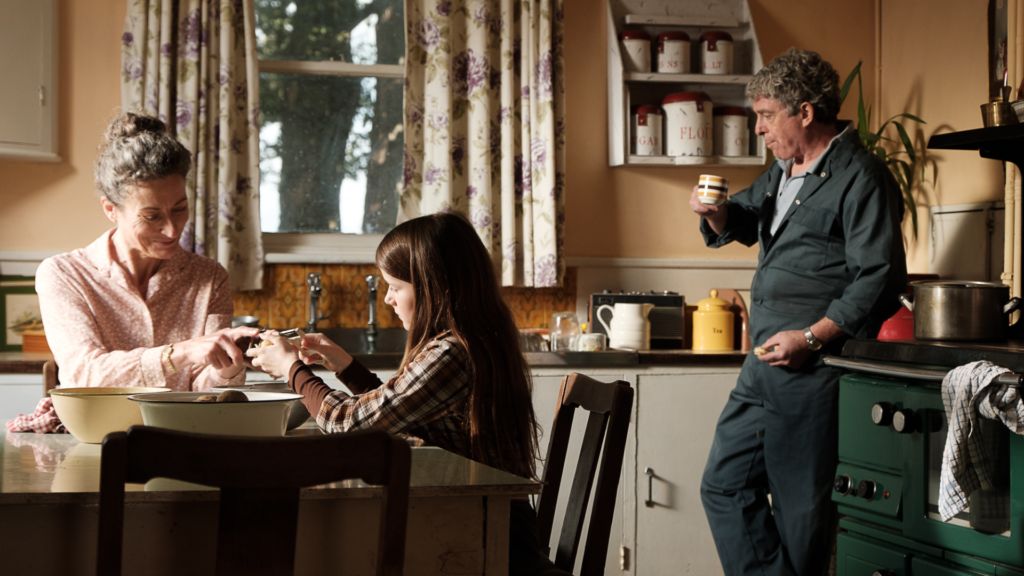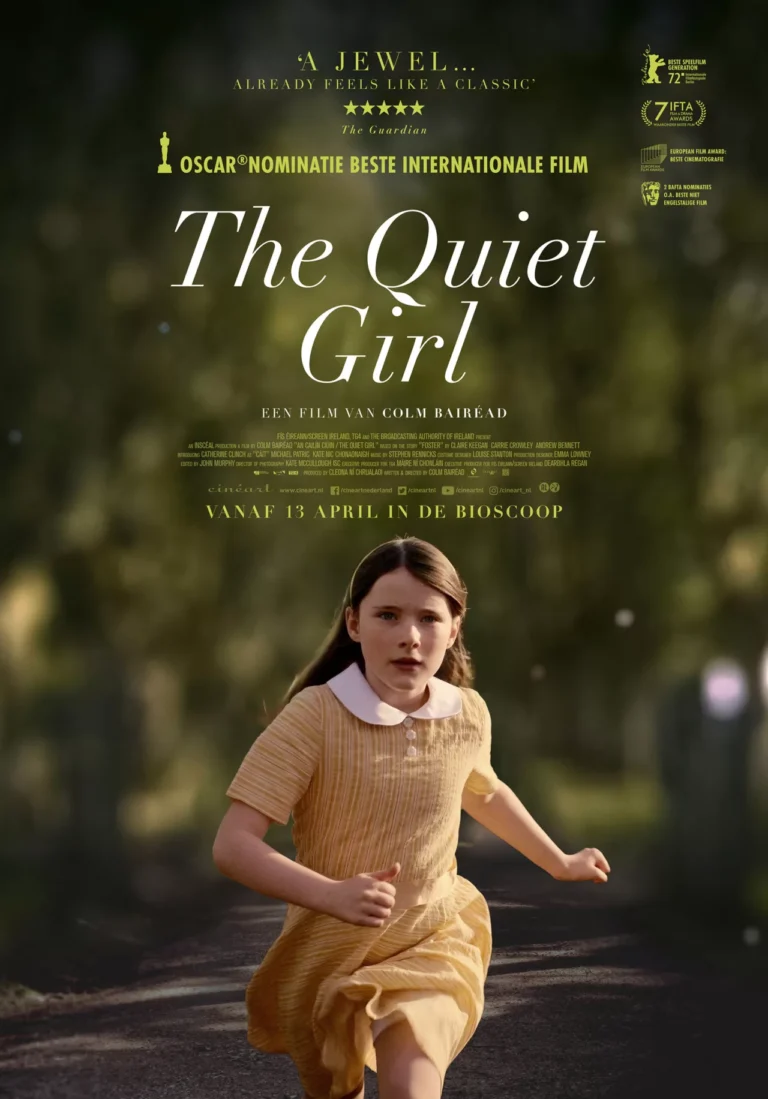The Quiet Girl – Snapshot
The Quiet Girl is, quite possibly, the best movie of the year. About a young girl who, during a summer with distant relatives, learns just what it means to enjoy love and respect. Just 95 minutes long, it is a rare gem of a movie – conveying what is best about cinema!
Where to Watch:
Stream: Hulu
Rent: Prime/Google ($3); Apple/Redbox/Vudu ($4)
The Quiet Girl – The Oscar Buzz
Oscar Nominations:
International Feature Film (Ireland)
The Quiet Girl received a single nomination for International Feature Film, putting it in our list of special interest films. It is, reportedly, the first film made by an Irish production company to receive an Oscar nomination. (Note: there are other “Irish” movies that have received Oscar nominations, such as this year’s The Banshees of Inisherin and last year’s Belfast but those films were produced or co-produced by American and/or British companies.)
The Quiet Girl – The Movie’s Family Tree
The Following Movies Share Talent with This One (and if you like these films, you might like this one):
Normal People (20) (TV series): Composer (Rennicks); Cinematographer (McCullough); Sound (Flanagan)
Room (15): Composer (Rennicks); Sound (Flanagan)
The Quiet Girl is an Irish film through and through – filmed in Ireland with an almost exclusively Irish cast and crew and financed and produced by Irish organizations. Director and writer Colm Bairead was born in Dublin in 1981. Although he has directed and/or written some TV episodes and film shorts, The Quiet Girl is his first feature film.
Reviewing the filmographies of the rest of the crew and cast, they all (except for newcomer Catherine Clinch) have extensive experience making films and TV series in Ireland, but, quite frankly, I wasn’t familiar with any of them. But I’m inclined to think that, if you like Irish cinema, you may well be disposed to see this film. (There are, though, many more reasons…)
The dialogue switches back and forth a bit between Gaelic (Irish) and English and I found that a bit strange, but it probably reflects the reality of language in Ireland, especially in the 1980s, when the film is set. Being about half Irish blood myself, I confess to having some attraction to the culture.
Little, though, will prepare you for the impact that the main character, Cait (and even after two viewings, I’m still not sure how her name is pronounced), will have on you. She is portrayed by Catherine Clinch who was only 11 or 12 when the movie was filmed and she has never acted in a movie before. But she has a powerful presence and a mastery of expressing so much without saying a thing. In all her scenes watch her big blue eyes, and the sensitive lines around her forehead and mouth, and the way she tilts her head. So another part of the movie’s family tree is to see this child actress perform.
Finally, the movie is an adaptation of Claire Keegan’s “Foster”. If you are familiar with that book, you might want to see this movie. (Confession: I haven’t read the book! – too busy watching movies to read books…)
The Quiet Girl – What Others Think
The Quiet Girl places just one point behind Argentina, 1985, in audience ratings among this year’s International Features, third among all 15 special interest films, and comes in fifth among all 39 of this year’s movies, tied with The Whale. While Top Gun: Maverick still ranks number one and isn’t like this film at all, Women Talking came in just a point above The Quiet Girl, and shares attributes of subtlety and emotional expression.
Critics also rate The Quiet Girl very similar to Women Talking and placed it first among the International Films, and second among all special interest movies only to the Documentary All That Breathes. Sheila O’Malley (RogerEbert) uses comments like “unfolds like a reverie” and, talking about the final sequence noted that it “completely knocked me flat…The film works by stealth.” MaryAnn Johanson (FlickFilosopher) – who is normally pretty critical – wrote “one of the most beautiful movies I’ve ever seen. It is impossibly small, and emotionally immense…a treasure, and a gift.”
In short, almost anyone who sees this movie loves it… so, if it matters what others think, then get this on your list.
The Quiet Girl – Special Mention
The Irish and the Movies – The Quiet Girl , as noted above, is an Irish film. And the fact that I know so little about Irish films made me do a bit of exploration.
Writing in the New York Times, Roisin Lanigan (“In The Quiet Girl, an Irish Loneliness Rarely Seen Onscreen”, notes that the film brings out what is almost a trait of Irish national character: “Although verbal expressions of emotion might continue to be culturally difficult for Cait and for those around her, in the film’s powerful final moments, we see the child running, silently toward love.” Director and Writer Colm Bairead notes that, in his film, “So much of it is under the surface, There’s this emotional reticence that hangs over everything.”
If you’ve seen The Banshees of Inisherin or Belfast, you will notice the exact same thing – the Irish are more reserved in expressing their feelings than, perhaps, even the British. The Quiet Girl shows us that this just might be something deeply rooted in how these people grow up as children.
Other important “Irish” films that you might want to explore to get even more of this feeling include The Wind that Shakes the Barley, Once, The Song of the Sea, and Brooklyn. I haven’t seen the first one, but the other three definitely contribute to this expression of Irish national character.
The Quiet Girl – Michael’s Moments
The Quiet Girl is a great example of what filmmaking can achieve when it wants to – it tells a powerful story with economy and feeling. Frankly, it is difficult to find any faults with this movie.
On the surface, the movie is a story of a young girl, Cait, who has the unfortunate luck of being the middle child with two older sisters, a younger sister and brother and, importantly, another child on the way. The family isn’t exactly functional, although there is no sign that Cait is ever physically or sexually abused (except maybe she is frequently hungry!). But she has assumed certain personality traits, including expectations about what life is all about, as a means of adapting to her environment. We learn all of this in the first fourteen minutes of the movie, during which she speaks maybe two full sentences – The Quiet Girl!.
Then her situation changes – she is farmed out to distant relatives. There the young girl learns much about a different way of life and the effects are profound. One critic called this a coming-of-age story, and I take real exception to that. This isn’t about a girl becoming a women, this is about a girl becoming a really different girl. She learns so much about the possibilities of being human, you can tell that, whatever happens at the end, she has profoundly changed. I’ve read comments about the ending being unclear and unsatisfying, but I don’t think that’s true. The trajectory of the movie, and of Cait’s life, has been set and there isn’t a whole lot that can undo that. So I think what happens is very clear and not ambiguous at all. See what you think.
We watched The Quiet Girl just a day or so after finishing my review of Babylon. The contrast in these movies is so huge that it is difficult to believe they are in the same art form. Babylon is, of course, by, of, and for Hollywood and is loaded with everything that side of the industry represents. Populated with big name stars, extravagant sets and costumes, a convoluted story line – or should I say multiple story lines, and all to the end of dishing out a severely-R-rated morality tale of rather epic proportions. The credits go on forever and the budget of $110 million assuredly leads to an overstuffed mess, even if it had some moments.
The Quiet Girl is almost the exact opposite – the cast is small, just three main characters, two secondary players, and maybe a dozen other speaking parts. The cinematography was simple, employing an unusual squarish aspect ratio to give the look a boxed-in kind of feeling. The lush Irish landscape contrasts both in texture and colors with the cities and desert of Babylon’s Southern California. The music was subdued and almost lyrical instead of brash and in your face. And contrast the two leading women, Nellie (Margot Robbie) and Cait. Sure, Cait is a child, but which of the two do you really find easier to identify with?
I’ve often said that for a movie to be good, it does not have to necessarily be pleasant. A good horror flick is one that fills you with fear, dreading, and no small amount of disgust. And it works, as a movie, if it does all those things well (Remember The Exorcist??). So judge a film not by how good it makes you feel, but by how much it makes you feel. Babylon fails because, despite all of its excesses, the notion of a central emotion – a purpose for the movie – is lost in the bewildering excesses of its production values and complex story.
The Quiet Girl succeeds because the director never loses sight of the feeling he is trying to convey. As MaryAnn Johanson put it in her review, “it is impossibly small, and emotionally immense!” In an brief 95 minutes, this film takes you on an incomparable journey, deep into your heart. I suggest you will remember this movie a long time. (Oh, and bring a box of tissues!) (5*)



3 thoughts on “The Quiet Girl – Simple but with Huge Emotional Impact (5*)”
I read the novella, Foster, in about an hour and that included the time to look up some unfamiliar references. Loved the many layers of the story. Can’t wait to see the film!
An aside: I found the more vertically expansive aspect ratio of the film felt kind of liberating rather than boxed in, as you can tell from the adjectives I used. I’m biased toward a more squarish boundary shape, but I was surprised by the “boxed-in” description. I feel like the flatter 16:9 cinema ratios and 3:2 photo ratios are forcing me to look through an overly constrained window. My eyes see up and down as much as left and right. A squarish shape is more challenging for the cinematographer or photographer to use effectively because we live under the flattening thumb of gravity, but I still find the square shape to feel fresh and more relaxed.
I agree with you about this film. And the comparison with Babylon, cringe, really makes the point about the value and impact of nuance and subtlety. I can’t remember ever more wanting the film to not end yet.
Perhaps “boxed-in” conveys a negative feeling, but that’s not what I intended. I meant it similar to what you described. The squarish effect narrows the visual field and asks the mind to focus on what is really going on the film, not the side shows. So by “boxed in” I meant the notion of confining the visual and mental field – provides focus!
Glad you liked the film as much as I did.